 |
 |
 |
 |
 |
 |
|||||
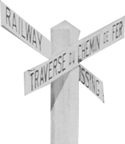 |
 |
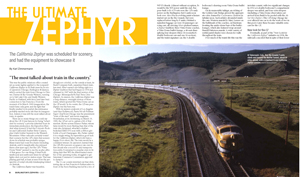
Once More the California Zephyr. In 1972, CZ: The Story of the California Zephyr, Karl Zimmermann's first book, was published. Over the years since, he's written often about the CZ, his favorite train, for publications as disparate as Travel & Leisure and Passenger Train Journal. Now, in November 2021, nearly half a century after the book's release, his "The Ultimate Zephyr," another appreciation of the Vista-Dome streamliner called "the most talked-about train in the country," appeared in a Classic Trains special edition called Burlington's Zephyrs: The Fast Silver Streamliners That Changed Railroading. Inaugurated in March 1949 with glamorous equipment and consciously scheduled for scenery, the train ran over three railroads—the Burlington Route, Rio Grande, and Western Pacific—between Chicago and Oakland, with a ferry (later bus) connection to San Francisco. Scenic highlights included 238 miles along the Colorado River and a traverse of California's Feather River Canyon, all in daylight. The lead photo, seen here, was made by Karl's wife, Laurel. As the author's bio reported, this was Zimmermann's 22nd article for a Classic Trains publication.
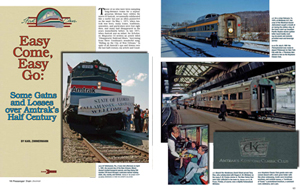
Back in Passenger Train Journal. When in early 2020 Karl Zimmermann retired after 13 years as "North American Intercity Rail" columnist, he remained on the masthead at PTJ as Contributing Editor. A year and a bit later, in that role he participated in the magazine's extensive, year-long coverage of Amtrak's 50th anniversary with "Easy Come, Easy Go: Some Gains and Losses Over Amtrak's Half-Century." This illustrated essay covers a number of Zimmermann's favorite trains that have come and gone—the short-lived Keystone Classic Club and purely Delaware & Hudson Adirondack—and events—the inauguration of the eastern extension of the Sunset Limited from New Orleans to Florida, making it the nation's first transcontinental train. He discusses the Pacific Parlour Car, which for many years made the Coast Starlight Amtrak's premier sleeping-car experience. The piece ends with a disappointing equipment failure aboard one of the long-anticipated Viewliner II sleepers en route from Savannah to New York as part of the Silver Meteor.

Preparing a collection. Last fall the Center for Railroad Photography & Art announced that it would become the permanent repository for Karl Zimmermann's railroad photography, making it part of its Railroad Heritage Visual Archive. The Zimmermann material comprises some 36,000 black-and-white and color images made from 1957 to the present. The Center is arguably the premier national organization now housing such collections, which include the work of Jim Shaughnessy, Victor Hand, John Gruber, and J. Parker Lamb. The Zimmermann material will go to the center for digitalizing beginning in 2022. The acceptance of Zimmermann's work was announced in the Fourth Quarter issue of Railroad Heritage, the Center's magazine, which carried a memoir of his life in photography, "In the Thrall of Trains," along with a selection of his photographs from North America and abroad. From now until his collection physically moves to the Center's new 1,450-square-foot archival space in Madison, Wis., its home base, Zimmermann will continue to prepare the material for accessioning.
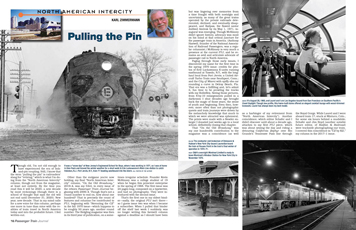
"Pulling the Pin" at Passenger Train Journal. After 13 years as "North American Intercity" columnist, from the very first issue of the reborn magazine, in the fourth quarter of 2006, Karl Zimmermann is retiring from that role—or "pulling the pin," in railroaders' slang. That totals 54 columns, including his sign-off, published in the First Quarter issue of PTJ. The previous column, "On the Old Broadway," was actually (and coincidentally) his one hundredth contribution to Passenger Train Journal, in its original incarnation, which ended in 1997, and the current revival which came nine years later. His first piece, "Rerouting the CZ," was published in the fall of 1970 in the fledgling PTJ. In the 50 years—another round number—since that first contribution, passenger railroading in North America has changed enormously. The stripping of amenities from Amtrak's long-distance trains in recent years has left Zimmermann feeling written-out on that narrow subject, so he welcomes the chance to remain on the Passenger Train Journal masthead as Editor-at-Large, with the wider purview that now suits him better.
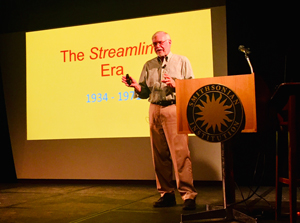
On stage for the Smithsonian Associates. The temperature in Washington D.C. was in triple digits on July 20, but the Discovery Theater, deep in the Smithsonian Associates complex, was cool and comfortable for an all-day seminar attended by a packed house of over 70: "America's Long-Distance Passenger Trains: On Track for a Renaissance or Extinction?" The Associates, a support group for the Smithsonian Institution, blurbed the event this way: "Explore train travel's romantic past, its present state, and its uncertain future with transportation professional Scott Hercik and a panel of experts including author and historian Karl Zimmermann, Bruce Goldberg, whose four decades in the transportation industry included 19 years at Amtrak, and Bob Johnston, who has covered passenger railroading for 28 years with Trains magazine."
Zimmermann began the program with "The Golden Age of Railway Travel," a PowerPoint presentation that covered the glory days of the streamliner era in America. After a lunch break, he shared the stage with Bob Johnston for "New Destinations," which looked at contemporary rail travel around the world in search of models that might work in America. The day wrapped up with "A Fresh Start or the End of the Line?" This all-hands-on-deck panel took a hard look at the outlook today for the long-distance passenger train in America, which is decidedly uncertain.

Coming down the track in August: Dining à la Pullman: The History of Pullman Dining Service, 1866-1968. In this definitive, colorful book, authors Terence Mulligan, Peter Tilp, and Karl Zimmermann explore in detail the equipment, amenities, food, and people that made this pleasurable, long-lost era of travel possible. The volume offers hundreds of illustrations of railway car exteriors and, especially, interiors, menus, silverware, china, and other memorabilia, plus the personnel who brought all this to life, while telling the history of an underreported part of a company famous for its sleeping cars. There are recipes for many Pullman favorites, plus in- depth interviews with Pullman chefs and waiters, all now gone. In addition, Tilp recounts his family company's acquisition and restoration of restaurant-sleeper Lotos Club. Arguably the most authentically restored heavyweight Pullman car in America, it today is a highlight of the Railroad Museum of Pennsylvania's collection in Strasburg, Pennsylvania.
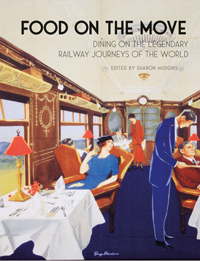
It's arrived: Food on the Move: Dining on the Legendary Rail Journeys of the World. Just released by Reaktion Books, a British publisher, this richly illustrated, 256-page volume is a compendium of essays on dining aboard nine of the world's most famous passenger trains. Karl Zimmermann contributed two chapters–on the Blue Train in South Africa and Santa Fe's long-gone but fondly remembered Super Chief–and seven other writers contributed one apiece. "Readers will appreciate all of the research that shines in each chapter," according to a review in Booklist, "but included photographs and recipes are sure to whet many a nostalgic appetite for a slower, more gentle, more genteel way of life and travel." The New York Times Book Review praises the "new collection of essays by various writers" for describing "dining by rail–in an exalted past and, in the book's tantalizing narratives, sometimes today–as an experience as exhilarating and varied as watching the scenery unfold mile by mile. . . . Americans who love trains above all other forms of travel," the reviewer adds, "will sigh loudest during a chapter on the glory days of the Santa Fe Super Chief from Los Angeles to Chicago, whose décor was inspired by the Native American tribes in the area the trains traversed."
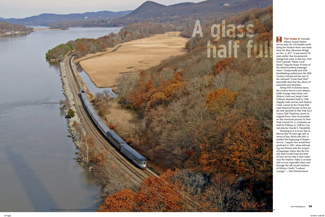
A double-header in DecemberTrains magazine.This issue featured two Zimmermann stories: "A Private 'Dude,'" about the members-only train that once served the Massachusetts elite, and "A Glass Half Full," which noted the fiftieth anniversary of the death of the 20th Century Limited, operated by New York Central between New York City and Chicago and considered by many the most famous train in the world. This two-pager featured a Zimmermann photo made along the Hudson River on December 2, 2017–the exact anniversary–of an Amtrak Empire Service train trailing Hickory Creek, an observation car built in 1948 for the Century and now operating in private ownership. The car was back on the route it had plied for nearly 20 years. The piece about the "Flying Dude," which operated between Boston and Woods Hole from 1884 to 1916 and served the rich and famous of the day, had appeared in slightly different form in Martha's Vineyard magazine. Also still on newsstands when these stories ran in Trains was the fall issue of Classic Trains, with Zimmermann's "Rambling on the Reading," about a series of wonderful steam-locomotive excursions in eastern Pennsylvania operated from 1959 to 1964 by the Reading Railroad.
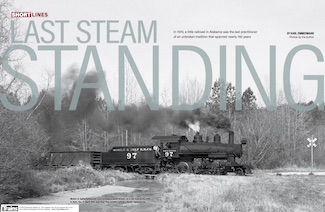
For "Last Steam Standing," an article that appeared in the short-line-focused summer 2018 issue of Classic Trains, Zimmermann dug deep into his photo archive and memory to document a March 1970 visit he and Laurel made to the Mobile & Gulf, a 13-mile-long railroad not far from Tuscaloosa, Ala. By that time the M&G had become the last steam-powered common-carrier railroad in America. Its locomotive, a shapely 1925-built Mogul-type, proved photogenic, as did deep-South environment, and the creosoting plant, the railroad's only shipper, in the company town of Brownville.
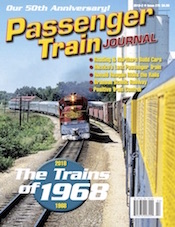
With the spring 2018 issue, Passenger Train Journal marked its 50th anniversary. When Kevin McKinney founded the magazine, long-distance passenger trains were in decline and peril, as they are again today. In McKinney's words, today's magazine continues "to report, advocate, editorialize, and provide historical perspective." Karl Zimmermann's first feature for the magazine ran in the fall of 1970, and 38 have followed - in addition to his 46 contributions as North American Intercity columnist for the magazine since it was reborn a dozen years ago. "Amtrak: Pinching Pennies Again and Again" appeared in the anniversary issue.
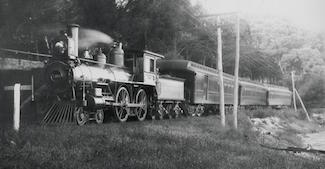
The trains of summer. The warm months of 2017 brought multiple stories by Karl Zimmermann about passenger trains that ran in diverse publications. The June issue of Martha's Vineyard magazine featured "Riding with the Dude," a chronicle of the seasonal private train that from 1884 to 1916 carried wealthy Bostonians from their offices in that city to summer retreats on Buzzards Bay or on the islands of Nantucket or Martha's Vineyard, reached via ferries from Woods Hole, where the "Dude" or "Flying Dude" ended its run. Its moniker was informal, since the train, open only to members of the "Train Club" and their guests, never appeared in a public timetable. Zimmermann's most recent previous piece for the magazine was also about flanged-wheel transport, "What Goes Around Comes Around," the story of the streetcars that long ago served the Martha's Vineyard towns of Oak Bluffs and Vineyard Haven.